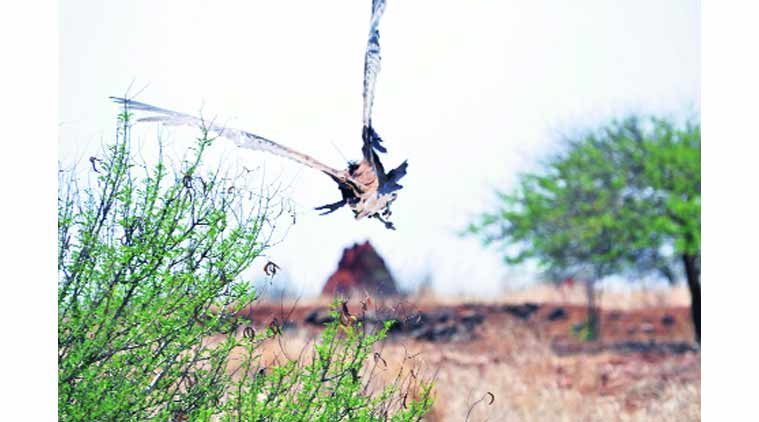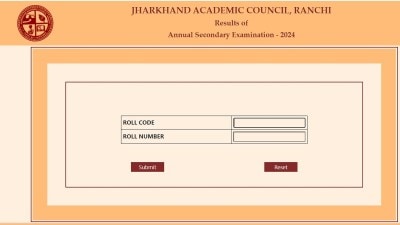- India
- International
Radio-collared Great Indian Bustard ‘Chotu’ travels 103 km to reach Karnataka border
For the first time, forest department officials knew exactly where Chotu, the Great Indian Bustard (GIB) went.
 Chotu flies off. (Express Photo)
Chotu flies off. (Express Photo)
‘Chotu’ covered a distance of approximately 103 km within a week of leaving the Nanaj Sanctuary. And, for the first time, forest department officials knew exactly where Chotu, the Great Indian Bustard (GIB) went.
Officials and researchers at the Nanaj sanctuary have been tracking Chotu since April and have found that the GIB travels well beyond the Nanaj Sanctuary into agricultural lands right up to the Karnataka border.
Tracking the movement of the bird, researchers found that during summer, Chotu roamed within the bounds of the sanctuary and adjacent agricultural lands, but once monsoon set in, Chotu left the sanctuary and travelled to various private lands dominated by agriculture.
[related-post]
“While the grasslands of Nanaj are breeding grounds for this bird from April-October (breeding season), we do not know where they migrate to during the non-breeding seasons and they are extremely elusive. To effectively conserve this bird, it was critical to identify all the habitats and regions used by them around the year, which led to the study,” said Sunil Limaye, chief conservator of forest, Pune Wildlife Wing.
Preliminary surveys have indicated that GIBs forage in agricultural lands during its peak activity hours, said Limaye. It was also found that during summer, the maximum distance travelled by Chotu was 8km. Until May-end, Chotu stuck to the sanctuary bounds save four different occasions, when he made use of crop lands much further away from Nanaj.

After monsoon set in June, within a week, Chotu covered a distance of approximately 103kms, reaching Karnataka border via Akkalkot in Solapur district. He travelled back towards Gangewadi in Solapur district and headed for Vairag in the same district. After a week there, Chotu is headed towards the Karnataka border once more, covering another 100kms, added Limaye.
In Maharashtra, the main breeding areas are Warora, Chandrapur, and Nanaj Bustard Sanctuary in Solapur. Through transmitters fitted on these birds, the forest department is trying to get a good insight into GIBs’ habitats and activities- something that has eluded researchers for a long time.
Chotu, a subadult GIB, was one of two male GIBs that arrived at Nanaj in February, the other one being an adult (Badu). On April 17, Chotu was tagged with a solar-powered platform terminal transmitter (PTT) by Wildlife Institute of India scientist Bilal Habib. Within two days, Chotu joined Badu, who aggressively threatened Chotu away from his territory, said research fellow Vaijayanti Vijayaraghavan.
The 70-gm PTT provides seven locations per day at 5 am, 7 am, 9 am,11 am, 5 pm,7 pm and 9 pm, which coincide with the peak activity time of the bird and its roosting hours.
Researchers found that the Great Indian Bustard uses agricultural areas in the morning, and use dense woodlands (20-50 per cent trees), open woodlands (10-20 per cent trees) or grasslands by 11 am. After 9 am, increased human activity in croplands, coupled with raising temperatures pushes Chotu to use woodland or tall grassland habitats for cover, said Limaye.
“This data is extremely crucial as it provides critical information about the Bustards’ movement ecology. Is there a mix with the population in Thar desert, how far does the bird travel, we can get all this information through this tracking,” said Vijayaraghavan.
“This study plays a key role in understanding the habitat requirements of this bird in various seasons. The data acquired over the past month has been almost entirely in areas outside protected regions. Its movement spans small areas across the landscape. We need to devise measures to integrate the local community in Bustard conservation in various areas across the landscape for their long term sustenance,” she added.
Apr 19: Latest News
- 01
- 02
- 03
- 04
- 05






































